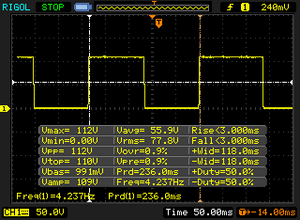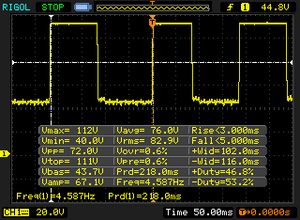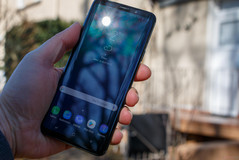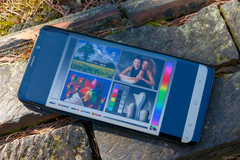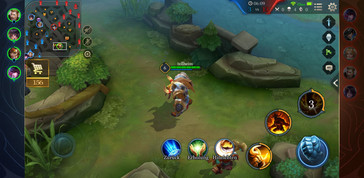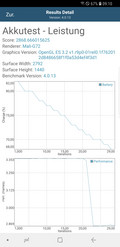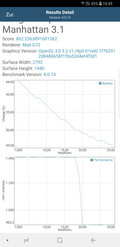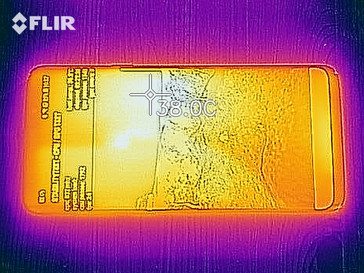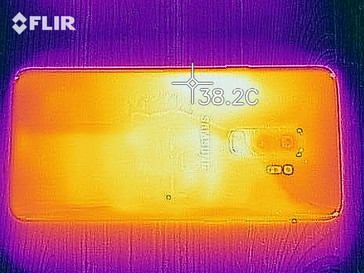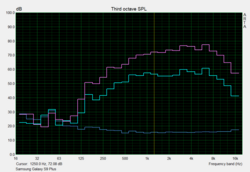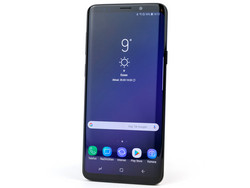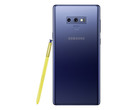Samsung Galaxy S9 Plus Smartphone Review

The Samsung Galaxy S9 Plus (SM-G965F) is the successor of the Galaxy S8+. After Samsung made fundamental changes to the design last year, the South Korean company has focused on fine-tuning for this year's model. This includes a new SoC, more RAM and a reworked camera which can now change between a 1.5 aperture and a 2.4 aperture automatically. The S9+ is also the first Galaxy S model with a dual camera.
The rest of the hardware is reminiscent of the predecessor: 64 GB of UFS 2.1 memory, support for microSD, a water- and dust-proof case, and an Infinity Edge display. In addition, the S9+ has Bluetooth 5.0, the fast LTE Cat. 18 standard, and a broad selection of sensors. This year's model comes with a price increase again. The Samsung Galaxy S9+ was released at a recommended retail price of 949 Euros (~$1167). In addition, a version with 256 GB is available exclusively in the Samsung Shop for 1049 Euros (~$1290).
The premium smartphone has to compete with devices such as the Apple iPhone X, the Huawei Mate 10 Pro, the LG V30, the Google Pixel 2 XL, the HTC U11 Plus, and the Motorola Moto Z2 Force. It also has to compete with less-expensive models such as the OnePlus 5T and the Honor View 10.
Update 05/29/2018: Samsung has released a new firmware. Details can be found in the Software section of this review.
Case - Samsung Phone Not Permanently Waterproof
The Samsung Galaxy S9 Plus has a stylish case made of Corning Gorilla Glass 5 and aluminum. It has a nice feel to it, even if it has a more angular appearance than its predecessor and weighs 17 grams more. It is available in the color options Midnight Black, Coral Blue and Lilac Purple.
The build quality is very high. The gaps are minimal and evenly distributed and the smartphone has a high torsion resistance. However, there are some slight creaking noises that come from inside the case. The Galaxy S9+ was featured in a Stiftung Warentest (a German consumer organization) survey, where it had to prove its worth in an extensive drop test. In opposite to its predecessor, it passed the test with only a few small scratches. It is nice to see that Samsung has improved on this aspect so effectively.
The protection label is still rather confusing, though. The manufacturer labeled the protection as IP68, which normally means that a phone is dust- as well as waterproof. In the fine print, however, Samsung reduced the nominal protection from permanent submersion into water to an only temporary (30 minutes) submersion in a depth of up to 1.5 meters - ergo IP67.
Depending on the model, the card tray at the upper edge of the smartphone can hold a nano-SIM and a microSD card, or two nano-SIM cards (Duos). Unfortunately, the tray is made of rather thin plastic. The battery is non-removable and hence cannot be changed by the user.
Connectivity - Nearly Everything Included in the Galaxy Smartphone
The Samsung Galaxy S9 Plus offers a broad selection of sensors which leaves almost nothing to be desired. Among other things, a heart-rate monitor is included again. All common mobile radio technologies are included as well. NFC, MST and Ant+ are offered besides Bluetooth 5.0. The Bluetooth radio supports dual audio and can connect to two speakers simultaneously. Furthermore, aptX is supported for high-resolution audio content.
According to the manufacturer's specifications, the microSD card slot supports cards with a capacity of up to 400 GB, which is the maximum capacity currently available at the time of testing. The SDXC standard goes up to 2 TB, so even cards with a higher capacity should not pose a problem in the future. Because of the great differences in performance between the internal and the optional storage, it is not possible to format a microSD card as internal storage or to transfer apps to it.
The USB port is of the current Type-C variant and supports the transfer standard 3.1 (Gen 1). It is also OTG-capable, so peripherals and storage devices can be connected via an adapter. Furthermore, it is possible to charge other devices via the Galaxy S9 Plus, and the port is capable of outputting HDMI and DisplayPort 1.2.
The only things users have to do without are an FM receiver and an IR transmitter.
Software - Android Oreo without Any Great Improvements
The operating system used for the Samsung Galaxy S9 Plus is Google Android 8.0 Oreo, expanded by the Korean company's own Samsung UI 9.0. From a purely visual point of view, the newer operating system barely differs from Android 7, which was used for the Galaxy Note 8 among others. At the time of writing, the security patch level is from March 1, 2018 and hence up-to-date.
Samsung's own assistant Bixby is included as well. However, it feels as if it has barely changed since its release and is still not offered in German, It is only offered in Korean, Chinese and English.
The new AR emojis feel more like a gimmick than a fully developed feature. Especially the live movements are usually understated and the mouth of the digital avatar often twitches nervously. We liked the social media stickers more, even though the recognition value is not very high.
Familiar features such as the Edge bar or the Game Launcher are included again as well, together with Samsung's own app store. Additionally, Microsoft and Facebook apps are preinstalled and cannot be removed completely, merely deactivated. Many Google apps, by contrast, can be deleted completely. Sadly, Samsung forwent the opportunity of setting up multiple user accounts on this smartphone.
Update 05/29/2018: Samsung has released a new firmware (356 MB) that is supposed to improve upon VoLTE and VoWifi. Dual VoLTE fr the Galaxy S9+ Duos has been added as well. Google’s security patches have been updated and are now as of May 1, 2018.
Communication - Galaxy Smartphone with Modern Standards
The Samsung Galaxy S9 Plus offers a broad selection of mobile carrier frequencies. The Korean company prefers several regional variants to a global one. The European version SM-G965F supports up to 35 frequency bands, while the US variant SM-G965U supports 40 and the Canadian G965W supports 41. These are not only LTE bands, but especially CDMA frequencies which are not required in Europe. The LTE module (Cat. 18) has a download speed of up to 1.2 Gbit/s, which makes the Samsung Galaxy S9 Plus one of the fastest phones to date. The reception was good within a big city and did not give us any reason for complaints.
The Wi-Fi module remains unchanged in comparison to the predecessor Galaxy S8 Plus. It supports the IEEE 802.11 standards a/b/g/n/ac with VHT80 MU-MIMO as well as 1024 QAM (10-bit quadrature amplitude modulation). On paper, the Galaxy S9 Plus should offer the same performance as its predecessor, but the Korean company did some fine-tuning and improved the download speed, but in turn the upload speed suffered slightly. Overall, the smartphone delivered a very good performance in combination with our reference router Linksys EA8500.
Users with several Wi-Fi access points in their office or home will notice that the Galaxy S9 Plus is sadly a bit slow with automatically changing to the stronger signal. During our reviewing time, this forced us to reset the Wi-Fi connection repeatedly to connect to the closer hotspot, which was rather annoying. However, this is a wide-spread issue with smartphones. Only the Huawei Mate 10 Pro stood out among the comparison devices because it can switch between access points significantly faster thanks to its Wi-Fi+ technology.
The Samsung Galaxy S9 uses the satellite navigation systems GPS, Glonass, BeiDou, QZSS, and Galileo for positioning, which makes it rather well equipped. In addition to that, it also has a barometer. Satellite tracking is almost immediate outdoors, but takes a bit longer inside of buildings. Even near a basement window, localization was still possible.
In order to assess the phone's localization abilities, we took the Galaxy S9+ on a bike ride to compare it with the bike computer Garmin Edge 500. Both systems actually measured the same distance and traced a very similar track even in direct comparison. This track was not entirely impeccable for either of the two systems but still gave a very good overall impression.
Call and Voice Quality
The telephone app of the Samsung Galaxy S9 Plus has undergone some slight changes in comparison to its predecessor, which made it much sleeker. The tab "Places" has been deleted without substitution and users can now only change between the list of recent calls, their own contacts and the numeric field.
The smartphone's call quality is good and gives no reason for complaints if the provider supports VoLTE. The 3G connection has noticeably more noise but is still at an overall good level. The noise suppression feature could work better, since clipped shreds of noise leak through from time to time. The speaker mode of the Galaxy S9 Plus worked well enough. Despite the slight echo, the smartphone can be placed on a table to have one's hands free. The device also supports telephone calls via Wi-Fi.
The Galaxy S9 Plus is available in both a single-SIM and a dual-SIM variant. The latter is named Duos and can hold an additional nano-SIM instead of a microSD card. However, dual-VoLTE is not possible.
Cameras - Powerful Dual Camera
The front camera (Samsung S5K3H1) of the Samsung Galaxy S9 Plus is the same one that is installed in the predecessor model. It offers 8 MP, an aperture of f/1.7 and even an autofocus. Furthermore, the camera offers numerous settings and filters. Thanks to the "selfie focus" feature, the front camera can take pictures which frame the subject with a blurred background. This works decently, but rivals such as the Pixel 2 XL or the iPhone X are even better at this. In daylight, the photos are good and can convince with a high sharpness and dynamic. It is still possible to take good pictures even in twilight, but there will be visible noise.
The front camera can record videos in numerous formats, including 18.5:9 (2224x1080 pixels) and QHD (2560x1440 pixels). The frame rate is limited to 30 FPS.
We took a closer look at the front camera's performance under controlled lighting conditions. In regard to its sharpness and level of detail, the camera reached its limits relatively fast. Finer details are slightly out of focus, but this can actually be an advantage for selfies.
The S9 Plus is the first smartphone belonging to the Galaxy S series which has a dual camera on its back. Samsung is offering a solution similar to the one used for the Galaxy Note 8. In addition to the main camera, which is also used for the smaller Galaxy S9, there is also a second lens which is supposed to improve the bokeh effect for portraits as well as serve as an optical zoom.
Samsung introduced an innovation for the main camera (Samsung SLSI_SAK2L3_FIMC_IS) and equipped it with a modular aperture that can adapt to the lighting conditions by switching between an f/1.5 and an f/2.4 aperture. This is especially useful for photos taken in daylight because it avoids overexposure in brighter areas and results in good, sharp pictures. The iPhone X has a slightly higher dynamic range, but the Galaxy S9 Plus has higher details. Even in situations with little ambient light, the smartphone does its job well. The pictures do not look quite as artificially brightened as they did for the Galaxy S8+ and have clearer edges. The color representation is rather good as well.
The Pro mode can lead to even better results. It enables the user to set the white balance, the light sensitivity (ISO 50 - 800), the exposure time (1/24000 - 10 s), the focus as well as the aperture size manually. Furthermore, pictures taken in Pro mode can be saved in the RAW format. The Live View feature has been improved slightly, but it still doesn't work reliably for long exposure times.
Pro mode is not offered for the second lens. Because of its low light sensitivity, it is meant for use in daylight and otherwise produces a lot of noise in its pictures. It is a definite pro, however, that both of the dual camera's lenses are equipped with an optical image stabilizer (OIS).
The Samsung Galaxy S9 Plus is finally able to record videos in Ultra HD with up to 60 frames per second. The colors are saturated rather strongly, but the video recordings are really good. Sadly, the maximum recording duration in these settings is limited to five minutes. In UHD with 30 fps or in Full HD with 60 fps, it is limited to ten minutes.
Another innovation is the Super Slow Motion mode with 960 frames per second, which debuted last year in the Sony Xperia XZ Premium. Samsung predefines a square within the image to activate the mode automatically if the camera detected motion inside of it. This is a great idea and works well, especially because it is possible to do so up to four times per video. Sadly, the quality of the recordings is acceptable only in optimal lighting conditions and declines sharply in weaker light, resulting in a rather noisy and dark picture. The low video resolution (720p) limits their usage to social media applications. Sony is a bit further ahead in this regard and allows Full HD video-recording in the Xperia XZ2, albeit without the convenient automatic activation.
We also took a closer look at the Samsung Galaxy S9 Plus's dual camera under controlled lighting conditions. The variations between the different lenses and aperture modes are apparent. The f/2.4 aperture of the main lens had the highest level of detail and good color gradients. The decline of sharpness is visible the most clearly in the two upper corners and is slightly stronger on the right. The f/1.5 aperture still takes good pictures, although finer details are no longer depicted flawlessly even in the center of the image. The level of detail is still better than with the telephoto lens which has the weakest performance in this area.
We assessed the dual camera's color accuracy with the ColorChecker Passport. The bottom half of each field in the images below displays the reference color. As expected, the saturation is a bit stronger but not too garish. The telephoto lens has noticeably darker colors than the main lens.
Accessories and Warranty
The scope of delivery of the Samsung Galaxy S9 Plus includes a black modular power supply (9.0 V, 1.67 A; 5.0 V, 2.0 A), a suitable USB cable (Type-A to Type-C), two OTG adapters (Type-C to Type-A and Type-C to Micro-USB), a SIM tool, an AKG in-ear headset with covers in different sizes as well as several leaflets regarding security and warranty, and a quick-start guide. In some countries, a silicone case is added to the package, but this did not happen for us in Germany.
Numerous optional accessories are available via Samsung's online shop, including several covers and an inductive charger (75 Euros, ~$92) among other products.
Samsung offers a two-year warranty for their product, while the included accessories have a warranty of only six months and the battery has 12 months. The merchant warranty is not affected by this.
It is possible to purchase the optional Samsung Mobile Care package for a surcharge of 119 Euros (~$146; 159 Euros, ~$195, for the 256 GB variant). This package covers cases such as a broken display, damage caused by liquids, or battery faults for 24 months. Each damage case requires a deductible of 10% of the purchase price from the customer.
Please see our Guarantees, Return Policies and Warranties FAQ for country-specific information.
Input Devices & Handling
Samsung did not change much about the handling for the Galaxy S9 Plus. The capacitive touchscreen is protected by Corning Gorilla Glass 5 and supports up to 10-point gestures. Inputs are registered reliably and processed quickly. Samsung still uses their own keyboard layout, which has a rather clean appearance, but it often produces extra work with its automatically activated spell check. The layout can be easily replaced by any other app available in the Play Store.
The smartphone's physical keys have a high quality and fit well. Other than the power button, they include the volume rocker and the Bixby button. Even when the phone is locked, the Bixby button displays an overview of upcoming appointments, information about the weather, Samsung Health, and news, among other things. After configuring Bixby for the first time, this button can be deactivated as well. Sadly, it cannot be assigned to another function.
Fortunately, the fingerprint reader has been repositioned and can now be found beneath the Galaxy S9 Plus' dual camera, which makes it much easier to reach. The sensor's recognition rates are good, but the unlock speed could really be faster. The alternatively or additionally offered facial recognition and the iris scanner are even slower and the facial recognition is not very secure. Another disadvantage of the iris scanner is being forced to lift the Galaxy smartphone to face level to allow for accurate recognition. Apple's Face ID, for instance, does a much better and faster job at this.
The Android user interface can be found on the display again. The one-handed mode can be enabled with a swipe gesture as well as a triple tap on the on-screen home button. This mode shrinks the screen to a manageable size.
Display - Slightly Optimized Galaxy S8 Panel
The Super AMOLED display of the Samsung S9 Plus received only a small amount of fine-tuning in comparison to its predecessor, which is not even a disadvantage because this is an excellent panel. The display measures 6.2-inches (15.75 cm, 97.56 cm²). With its 18.5:9 aspect ratio, the smartphone offers a resolution of 2960x1440 pixels, although the factory settings are lower at 2220x1080 pixels. This saves battery power, but to be able to enjoy the display's full splendor, the settings should be changed.
The luminosity of the Infinity Edge display is just slightly above the predecessor's level and reaches an average of 571 cd/m² on a fully white screen if the ambient light sensor is activated. If the dark and bright areas are distributed evenly (APL50), the panel reaches up to 691 cd/m² when measured at the display's center, which is a lower result than the Galaxy S8+ had. During the presentation, Samsung promised up to 1000 cd/m². If the brightness is adjusted manually, only 325 cd/m² is available.
However, the brightness is distributed very evenly and the panel is able to display absolute blackness thanks to its OLED technology, meaning its contrast ratio could theoretically tend towards infinity. An eye-friendly blue-light filter is included as well and that, together with the low minimum brightness, makes the smartphone well suited to reading in the evening. Sadly, the Galaxy S9 Plus utilizes pulse-width modulation (PWM) for regulating the display brightness, which tires the eyes and can even lead to headaches for sensitive users. The low frequency is not exactly an advantage for this, but at least the amplitude curve is very flat to even it out. The "Always on Display" feature, which we are already familiar with from the predecessor model, and HDR support are included as well.
| |||||||||||||||||||||||||
Brightness Distribution: 96 %
Center on Battery: 565 cd/m²
Contrast: ∞:1 (Black: 0 cd/m²)
ΔE ColorChecker Calman: 2.3 | ∀{0.5-29.43 Ø4.77}
ΔE Greyscale Calman: 1.9 | ∀{0.09-98 Ø5}
Gamma: 2.16
CCT: 6332 K
| Samsung Galaxy S9 Plus Super AMOLED, 2960x1440, 6.2" | Samsung Galaxy S8 Plus Super AMOLED, 2960x1440, 6.2" | Apple iPhone X Super AMOLED, 2436x1125, 5.8" | Huawei Mate 10 Pro OLED, 2160x1080, 6" | Google Pixel 2 XL P-OLED, 2880x1440, 6" | HTC U11 Plus Super LCD 6, 2880x1440, 6" | OnePlus 5T AMOLED, 2160x1080, 6" | |
|---|---|---|---|---|---|---|---|
| Screen | 11% | 19% | 8% | -24% | -15% | -8% | |
| Brightness middle (cd/m²) | 565 | 560 -1% | 600 6% | 629 11% | 415 -27% | 361 -36% | 425 -25% |
| Brightness (cd/m²) | 571 | 562 -2% | 606 6% | 636 11% | 420 -26% | 356 -38% | 423 -26% |
| Brightness Distribution (%) | 96 | 93 -3% | 94 -2% | 94 -2% | 87 -9% | 90 -6% | 92 -4% |
| Black Level * (cd/m²) | 0.21 | ||||||
| Colorchecker dE 2000 * | 2.3 | 1.7 26% | 1.2 48% | 1.7 26% | 2.7 -17% | 2.5 -9% | 2.1 9% |
| Colorchecker dE 2000 max. * | 4.8 | 3.4 29% | 3 37% | 3.6 25% | 4.3 10% | 5.3 -10% | 3.4 29% |
| Greyscale dE 2000 * | 1.9 | 1.6 16% | 1.6 16% | 2.4 -26% | 3.3 -74% | 1.7 11% | 2.5 -32% |
| Gamma | 2.16 102% | 2.13 103% | 2.23 99% | 2.15 102% | 2.36 93% | 2.21 100% | 2.32 95% |
| CCT | 6332 103% | 6435 101% | 6707 97% | 6337 103% | 6787 96% | 6580 99% | 6455 101% |
| Color Space (Percent of AdobeRGB 1998) (%) | 81.57 | ||||||
| Color Space (Percent of sRGB) (%) | 99.87 | ||||||
| Contrast (:1) | 1719 |
* ... smaller is better
Screen Flickering / PWM (Pulse-Width Modulation)
| Screen flickering / PWM detected | 215.5 Hz | ||
The display backlight flickers at 215.5 Hz (worst case, e.g., utilizing PWM) . The frequency of 215.5 Hz is relatively low, so sensitive users will likely notice flickering and experience eyestrain at the stated brightness setting and below. In comparison: 53 % of all tested devices do not use PWM to dim the display. If PWM was detected, an average of 8083 (minimum: 5 - maximum: 343500) Hz was measured. | |||
We assessed the Super AMOLED display's color accuracy with a photospectrometer and the analytical software CalMAN. In factory settings, Samsung activated a display optimization for compatible apps. However, this profile usually leads to rather cool colors. A more natural color representation can be achieved by manually optimizing the settings. The screenshot shows the settings for a color representation that is as natural as possible, using the rather large color space DCI-P3.
The remaining three predefined profiles differ mostly by their target color space. By now, all modes aim for a white point that is as natural as possible. The cinema mode uses the DCI-P3 color space as well, while the photo mode utilizes a smaller version of the Adobe RGB color space to be able to display more shades of green. We measured the most accurate color representation in the Easy mode, but this mode also supports only the smallest color space (sRGB).
The DeltaE deviations are minor in any of the modes. Solely the Adaptive Display mode had a tint (blue) visible to the human eye. The colors had smaller outliers, but not even those were severe or disturbed the image. In photo mode for instance, the color green (dE 4.3) shows the highest deviation. Some of the competitors have an even more accurate color representation, especially the iPhone X, and also the Huawei Mate 10 Pro after adjusting the settings.
Display Response Times
| ↔ Response Time Black to White | ||
|---|---|---|
| 6 ms ... rise ↗ and fall ↘ combined | ↗ 3 ms rise | |
| ↘ 3 ms fall | ||
| The screen shows very fast response rates in our tests and should be very well suited for fast-paced gaming. In comparison, all tested devices range from 0.1 (minimum) to 240 (maximum) ms. » 17 % of all devices are better. This means that the measured response time is better than the average of all tested devices (20.2 ms). | ||
| ↔ Response Time 50% Grey to 80% Grey | ||
| 8 ms ... rise ↗ and fall ↘ combined | ↗ 3 ms rise | |
| ↘ 5 ms fall | ||
| The screen shows fast response rates in our tests and should be suited for gaming. In comparison, all tested devices range from 0.165 (minimum) to 636 (maximum) ms. » 19 % of all devices are better. This means that the measured response time is better than the average of all tested devices (31.6 ms). | ||
The viewing-angle stability of the Galaxy S9+ is at about the same level as the predecessor's. Even at very flat viewing angles, the slight color sheen that is typical for OLED displays is only visible starting at about 100 degrees, accompanied by a slight decrease in brightness. The Infinity display has no ghosting, glow or clouding effects at all, though.
Performance - The Galaxy S9+ Has Increased CPU Power
The Samsung Galaxy S9+ utilizes the Korean company's new top-notch SoC, the Exynos 9810. The CPU consists of two clusters. The performance cluster uses four Exynos M3 cores, which clock at up to 2.9 GHz. The energy-saving cluster is powered by four ARM Cortex-A55 cores, which can only reach 1.9 GHz. The system is supported by 6 GB LPDDR4x RAM. According to Samsung, this increase of RAM in comparison to the Galaxy S9 was necessary for the dual camera. An ARM Mali-G72 MP18 is responsible for graphics calculations.
The CPU performed well in our benchmarks and reached top scores in Geekbench. Only the iPhone X is even faster. AnTuTu v6 showed similar results, but in this case the Galaxy smartphone was able to outdo the Apple rival. In other system benchmarks, such as Basemark OS II and PCMark, Samsung's flagship smartphone achieved only mid-range results. The perceived system performance is good, but there are some small stutters.
The new GPU delivers a 12 to 41% higher performance in GFXBench but cannot outdo the iPhone in our off-screen tests. During the onscreen tests, which we conducted in maximum resolution, several Android rivals had better frame rates because they did not utilize QHD. The Galaxy S9+ fared even worse in 3DMark. Some competitors with the theoretically weaker Snapdragon 835 had better results in the more demanding benchmarks.
| AnTuTu v7 - Total Score (sort by value) | |
| Samsung Galaxy S9 Plus | |
| Apple iPhone X | |
| Huawei Mate 10 Pro | |
| Google Pixel 2 XL | |
| HTC U11 Plus | |
| OnePlus 5T | |
| Average Samsung Exynos 9810 (236552 - 250577, n=3) | |
| Lightmark - 1920x1080 1080p (sort by value) | |
| Samsung Galaxy S9 Plus | |
| Samsung Galaxy S8 Plus | |
| Huawei Mate 10 Pro | |
| Google Pixel 2 XL | |
| HTC U11 Plus | |
| Average Samsung Exynos 9810 (34 - 35.8, n=2) | |
| Basemark ES 3.1 / Metal - offscreen Overall Score (sort by value) | |
| Samsung Galaxy S9 Plus | |
| Samsung Galaxy S8 Plus | |
| Apple iPhone X | |
| Huawei Mate 10 Pro | |
| Google Pixel 2 XL | |
| HTC U11 Plus | |
| Average Samsung Exynos 9810 (1436 - 1481, n=3) | |
| Average of class Smartphone (205 - 7731, n=34, last 2 years) | |
Browsing the web is really fun on the Samsung Galaxy S9+ and works quickly in the preinstalled Samsung browser. The Samsung smartphone does a good job in the synthetic benchmarks as well and is beaten only by the iPhone X. In WebXPRT, however, the Galaxy places only in the middle of our comparison field.
| JetStream 1.1 - Total Score | |
| Apple iPhone X (IOS 11.1.1) | |
| Samsung Galaxy S9 Plus (Samsung Browser 7.0) | |
| Motorola Moto Z2 Force (Chrome 63.0.3239.111) | |
| OnePlus 5T (Chrome 63) | |
| Average Samsung Exynos 9810 (62.9 - 69.6, n=4) | |
| HTC U11 Plus (Chrome 63) | |
| Google Pixel 2 XL (Chrome 62) | |
| Samsung Galaxy S8 Plus (Samsung Browser 5.2) | |
| Huawei Mate 10 Pro (Chrome 61) | |
| LG V30 (Chrome 62) | |
| Octane V2 - Total Score | |
| Average of class Smartphone (2228 - 126661, n=195, last 2 years) | |
| Apple iPhone X (IOS 11.1.2) | |
| Samsung Galaxy S9 Plus (Samsung Browser 7.0) | |
| Average Samsung Exynos 9810 (12933 - 15233, n=4) | |
| Samsung Galaxy S8 Plus (Samsung Browser 5.2) | |
| Motorola Moto Z2 Force (Chrome 63.0.3239.111) | |
| OnePlus 5T (Chrome 63) | |
| HTC U11 Plus (Chrome 63) | |
| Google Pixel 2 XL (Chrome 62) | |
| LG V30 (Chrome 62) | |
| Huawei Mate 10 Pro (Chrome 61) | |
| Mozilla Kraken 1.1 - Total | |
| LG V30 (Chrome 62) | |
| Huawei Mate 10 Pro (Chrome 61) | |
| Google Pixel 2 XL (Chrome 62) | |
| Motorola Moto Z2 Force (Chrome 63.0.3239.111) | |
| HTC U11 Plus (Chrome 63) | |
| OnePlus 5T (Chrome 63) | |
| Average Samsung Exynos 9810 (2060 - 3189, n=4) | |
| Samsung Galaxy S8 Plus (Samsung Browser 5.2) | |
| Samsung Galaxy S9 Plus (Samsung Browser 7.0) | |
| Average of class Smartphone (257 - 28190, n=155, last 2 years) | |
| Apple iPhone X (IOS 11.1.2) | |
| WebXPRT 2015 - Overall | |
| Apple iPhone X (Safari Mobile 11.0) | |
| Google Pixel 2 XL (Chrome 62) | |
| OnePlus 5T (Chrome 63) | |
| HTC U11 Plus (Chrome 63) | |
| Average Samsung Exynos 9810 (163 - 202, n=3) | |
| Samsung Galaxy S9 Plus (Samsung Browser 7.0) | |
| Motorola Moto Z2 Force (Chrome 63.0.3239.111) | |
| Huawei Mate 10 Pro (Chrome 61) | |
| Samsung Galaxy S8 Plus (Samsung Browser 5.2) | |
| LG V30 (Chrome 62) | |
* ... smaller is better
Our test device is equipped with 64 GB of UFS 2.1 storage, 50 GB of which is available to the user after booting the system for the first time. A variant with 256 GB is available exclusively in the Samsung shop, while the variant with 128 GB is not offered in Europe. The top speeds of the Galaxy's storage are really good; merely the reading and writing of small data blocks is performed quicker by some competitors.
We tested the speed of the microSD card slot with our reference card, the Toshiba Exceria Pro M501. The transfer rates are at a decent level, although they do not nearly reach the full potential of the card.
| Samsung Galaxy S9 Plus | Samsung Galaxy S8 Plus | LG V30 | HTC U11 Plus | Motorola Moto Z2 Force | Huawei P10 Plus | Average 64 GB UFS 2.1 Flash | Average of class Smartphone | |
|---|---|---|---|---|---|---|---|---|
| AndroBench 3-5 | -12% | -28% | 77% | 38% | 81% | 40% | 637% | |
| Sequential Read 256KB (MB/s) | 819 | 788 -4% | 669 -18% | 728 -11% | 696 -15% | 733 -11% | 696 ? -15% | 2248 ? 174% |
| Sequential Write 256KB (MB/s) | 204.9 | 194.2 -5% | 193.2 -6% | 207.9 1% | 213.6 4% | 182.6 -11% | 224 ? 9% | 1887 ? 821% |
| Random Read 4KB (MB/s) | 129.7 | 127.2 -2% | 78.2 -40% | 132.4 2% | 148.8 15% | 173.1 33% | 137.2 ? 6% | 299 ? 131% |
| Random Write 4KB (MB/s) | 22.74 | 15.27 -33% | 10.21 -55% | 135.7 497% | 78.6 246% | 149.8 559% | 84.7 ? 272% | 346 ? 1422% |
| Sequential Read 256KB SDCard (MB/s) | 79.2 ? | 71.1 ? -10% | 62.8 -21% | 75.4 ? -5% | 77.4 ? -2% | 54 ? -32% | 68.6 ? -13% | |
| Sequential Write 256KB SDCard (MB/s) | 67.2 ? | 57.2 ? -15% | 47.2 -30% | 51.3 ? -24% | 54.7 ? -19% | 33.61 ? -50% | 52.2 ? -22% |
Games - The Galaxy S9+ Thwarts Itself
The Samsung Galaxy S9 Plus has one of the most powerful SoCs currently available for smartphones, and in addition it has a display with a high resolution, and dual speakers. Usually this would be a great combination, but sadly the Korean company does not always exhaust the smartphone's possibilities and instead restrains its performance with frame limitations, as was the case with titles such as Asphalt 8 and Dead Trigger 2. The other games we tested with GameBench had great results with constantly high frame rates.
The sensors and the touchscreen did not give any reason for complaint, and they reacted quickly and reliably to inputs.
| Asphalt 8: Airborne | |||
| Settings | Value | ||
| high | 30 fps | ||
| Dead Trigger 2 | |||
| Settings | Value | ||
| high | 30 fps | ||
| Battle Bay | |||
| Settings | Value | ||
| full resolution | 60 fps | ||
| World of Tanks Blitz | |||
| Settings | Value | ||
| high, 0xAA, 0xAF | 59 fps | ||
| Arena of Valor | |||
| Settings | Value | ||
| high HD | 60 fps | ||
| Shadow Fight 3 | |||
| Settings | Value | ||
| high | 60 fps | ||
Emissions - Samsung Smartphone with Good Speakers but Weaker Battery
Temperature
While idling, the surface temperatures of the Samsung Galaxy S9 Plus are only marginally higher than the surrounding temperature. The smartphone warms up noticeably only under constant load, reaching body temperature at some spots.
We tested the temperature behavior of the SoC with the GFXBench battery test, which runs a benchmark 30 times in a row and records the battery level as well as the frame rates. The results were similar in the T-Rex test (OpenGL ES 2.0) and the more-demanding Manhattan test (OpenGL ES 3.1). Samsung's chip appears very stable at the start but then has a strong performance drop after 21 (T-Rex) and 18 (Manhattan) iterations. The Galaxy S9+ delivers only about two-thirds of its initial performance in the Manhattan Test, while the performance loss in the T-Rex test is lower at 15%.
(+) The maximum temperature on the upper side is 35.8 °C / 96 F, compared to the average of 35.2 °C / 95 F, ranging from 21.9 to 247 °C for the class Smartphone.
(+) The bottom heats up to a maximum of 37.9 °C / 100 F, compared to the average of 34 °C / 93 F
(+) In idle usage, the average temperature for the upper side is 22.4 °C / 72 F, compared to the device average of 32.9 °C / 91 F.
Speakers - The Galaxy S9+ Finally Has Dual Speakers
For the first time in Samsung's premium series, dual speakers have been installed. These ensure not only a subjectively better sound experience but were also convincing in the lab. The playback of mids and highs is linear, but they are too far apart, which makes the sound appear unbalanced.
Fortunately, the Galaxy S9+ still offers an audio jack, which allows for low-noise playback. The included earphones are identical to those delivered with the predecessor model and offer a decent sound experience as long as the volume is not turned up too high. For those who prefer wireless earphones, aptX for Bluetooth is supported.
Samsung Galaxy S9 Plus audio analysis
(+) | speakers can play relatively loud (85.6 dB)
Bass 100 - 315 Hz
(-) | nearly no bass - on average 22.8% lower than median
(±) | linearity of bass is average (12.2% delta to prev. frequency)
Mids 400 - 2000 Hz
(+) | balanced mids - only 3.2% away from median
(+) | mids are linear (3.2% delta to prev. frequency)
Highs 2 - 16 kHz
(+) | balanced highs - only 4.4% away from median
(+) | highs are linear (4.8% delta to prev. frequency)
Overall 100 - 16.000 Hz
(±) | linearity of overall sound is average (17.3% difference to median)
Compared to same class
» 11% of all tested devices in this class were better, 8% similar, 81% worse
» The best had a delta of 11%, average was 35%, worst was 134%
Compared to all devices tested
» 32% of all tested devices were better, 8% similar, 60% worse
» The best had a delta of 4%, average was 24%, worst was 134%
Google Pixel 2 XL audio analysis
(+) | speakers can play relatively loud (88.4 dB)
Bass 100 - 315 Hz
(-) | nearly no bass - on average 28.1% lower than median
(±) | linearity of bass is average (9.5% delta to prev. frequency)
Mids 400 - 2000 Hz
(+) | balanced mids - only 3.2% away from median
(+) | mids are linear (5.5% delta to prev. frequency)
Highs 2 - 16 kHz
(+) | balanced highs - only 3.1% away from median
(+) | highs are linear (4.2% delta to prev. frequency)
Overall 100 - 16.000 Hz
(±) | linearity of overall sound is average (19.6% difference to median)
Compared to same class
» 29% of all tested devices in this class were better, 8% similar, 63% worse
» The best had a delta of 11%, average was 35%, worst was 134%
Compared to all devices tested
» 49% of all tested devices were better, 7% similar, 44% worse
» The best had a delta of 4%, average was 24%, worst was 134%
Apple iPhone X audio analysis
(+) | speakers can play relatively loud (85.3 dB)
Bass 100 - 315 Hz
(±) | reduced bass - on average 14.9% lower than median
(±) | linearity of bass is average (9.4% delta to prev. frequency)
Mids 400 - 2000 Hz
(+) | balanced mids - only 3.4% away from median
(+) | mids are linear (5.1% delta to prev. frequency)
Highs 2 - 16 kHz
(±) | higher highs - on average 7.3% higher than median
(+) | highs are linear (4.6% delta to prev. frequency)
Overall 100 - 16.000 Hz
(±) | linearity of overall sound is average (19% difference to median)
Compared to same class
» 24% of all tested devices in this class were better, 9% similar, 67% worse
» The best had a delta of 11%, average was 35%, worst was 134%
Compared to all devices tested
» 44% of all tested devices were better, 8% similar, 48% worse
» The best had a delta of 4%, average was 24%, worst was 134%
Frequency diagram in comparison (checkboxes can be turned on/off!)
Battery Runtime
Power Consumption
The power consumption of this Samsung smartphone is on a very low level but was measured at manually regulated luminosity. If the sensor is activated, the consumption at maximum brightness rises by 0.55 watts. The low consumption even under load can only be explained by the SoC's good energy management, since we could measure up to 10.5 watts when booting the Galaxy S9+.
The modular power supply (9.0 V, 1.67 A; 5.0 V, 2.0 A) could not be proven to have any power consumption on its own at all when plugged in. The "Always on Display" feature does not have a particularly high consumption, but it does raise the overall consumption in standby mode by 0.24 watts.
The Galaxy S9+ recharges fully within 241 minutes using the included power supply. Given the fact that Quick Charge is installed, this is way too long. It is to be expected that Samsung will improve this with an update. Wireless-charging is possible again as well.
| Off / Standby | |
| Idle | |
| Load |
|
Key:
min: | |
| Samsung Galaxy S9 Plus 3500 mAh | Samsung Galaxy S8 Plus 3500 mAh | Google Pixel 2 XL 3520 mAh | Apple iPhone X 2716 mAh | Huawei Mate 10 Pro 4000 mAh | LG V30 3300 mAh | HTC U11 Plus 3930 mAh | OnePlus 5T 3300 mAh | |
|---|---|---|---|---|---|---|---|---|
| Power Consumption | -6% | -59% | -67% | -22% | -21% | -33% | -22% | |
| Idle Minimum * (Watt) | 0.68 | 0.68 -0% | 1.28 -88% | 1.03 -51% | 0.85 -25% | 0.72 -6% | 0.51 25% | 0.58 15% |
| Idle Average * (Watt) | 0.95 | 1.13 -19% | 1.87 -97% | 2.4 -153% | 1.15 -21% | 1.37 -44% | 1.62 -71% | 1.44 -52% |
| Idle Maximum * (Watt) | 1.09 | 1.16 -6% | 1.89 -73% | 2.6 -139% | 1.23 -13% | 1.41 -29% | 1.87 -72% | 1.53 -40% |
| Load Average * (Watt) | 4.58 | 4.69 -2% | 3.73 19% | 2.96 35% | 4.12 10% | 3.46 24% | 3.92 14% | 3.17 31% |
| Load Maximum * (Watt) | 5.16 | 5.24 -2% | 8.08 -57% | 6.6 -28% | 8.42 -63% | 7.83 -52% | 8.27 -60% | 8.54 -66% |
* ... smaller is better
Battery Runtime
Considering the low power consumption of the Samsung Galaxy S9+, we are slightly surprised by the weaker battery runtimes, especially in comparison to its predecessor which performed much better in this area. Within our comparison field, the Galaxy S9 Plus' battery runtimes are disappointing as well. Only the Apple iPhone X does even worse, but it also has a significantly smaller battery.
The result of our Wi-Fi surfing test was especially weak. Even the Galaxy S8+ lasts 41% longer in this scenario. Users who regularly strain their Internet connection by surfing a lot will not have many battery reserves left in everyday use.
The usual energy-saving modes are available, but Samsung should still urgently improve the Galaxy S9 Plus' performance in this area with an update.
| Samsung Galaxy S9 Plus 3500 mAh | Samsung Galaxy S8 Plus 3500 mAh | Google Pixel 2 XL 3520 mAh | Apple iPhone X 2716 mAh | Huawei Mate 10 Pro 4000 mAh | OnePlus 5T 3300 mAh | Motorola Moto Z2 Force 2730 mAh | LG V30 3300 mAh | |
|---|---|---|---|---|---|---|---|---|
| Battery runtime | 21% | 16% | -7% | 47% | 24% | 23% | 31% | |
| Reader / Idle (h) | 22.4 | 26.1 17% | 28.4 27% | 21.5 -4% | 29.1 30% | 29.2 30% | 27.2 21% | 31.9 42% |
| H.264 (h) | 11.2 | 12.4 11% | 11.2 0% | 10.6 -5% | 15.5 38% | 13.3 19% | 13.5 21% | 13.7 22% |
| WiFi v1.3 (h) | 8.7 | 12.3 41% | 9.7 11% | 9.4 8% | 13.6 56% | 12 38% | 8.9 2% | 12.9 48% |
| Load (h) | 4 | 4.6 15% | 5 25% | 3 -25% | 6.6 65% | 4.3 8% | 5.9 48% | 4.5 13% |
Pros
Cons
Verdict
With the Galaxy S9 Plus, Samsung has managed to create a great smartphone again that received many sensible improvements but no real innovations. The main camera's two aperture levels are a great thing to have and work well in everyday life. Samsung has also optimized the image quality further. The Super Slow Motion mode is not much more than a gimmick for good lighting conditions and the resulting pictures are only suitable for social networks. The AR emojis do not work that well either. Any similarities to the user are mostly based on luck.
Be that as it may, the Korean company delivered a great product anyway. A fast processor, a great display, a better position for the fingerprint reader, storage that can be more easily expanded, good stereo speakers, and protection from dust and water are all certainly pros. Even a dual-SIM variant is available.
The Samsung Galaxy S9 Plus is a powerful smartphone, but it still has to struggle with some teething problems.
The Samsung smartphone is less convincing when it comes to battery runtimes, which are noticeably worse than they were for the predecessor model. Quick Charge also did not work for our test device so that it needed more than four hours to recharge fully in our test – much too long. Samsung will probably address these issues with an update, but this still leaves a bad taste in the mouths of users who purchased this smartphone for the full price at the start.
If you already own a Galaxy S8+, there is no acute reason to change now. The differences in everyday use are too small to justify the price disparity.
Samsung Galaxy S9 Plus
- 03/26/2018 v6 (old)
Daniel Schmidt


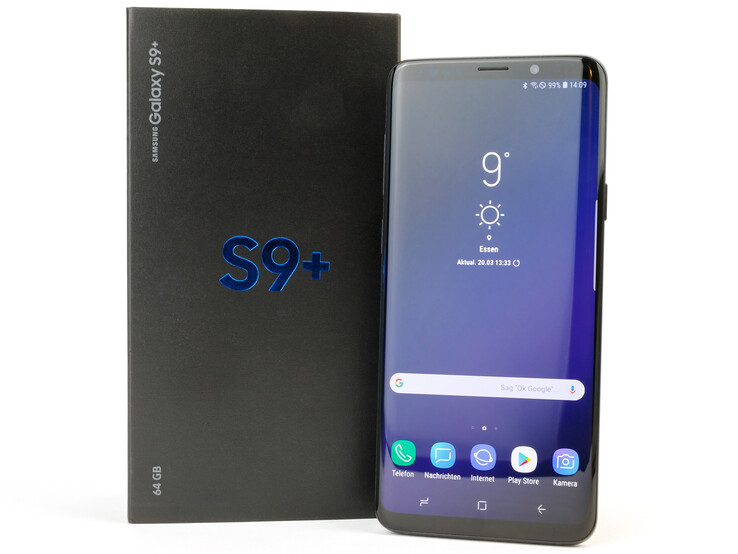











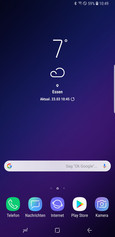
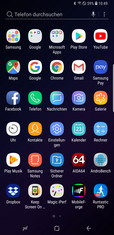
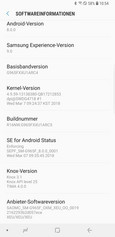
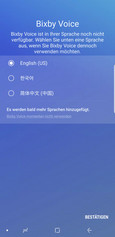





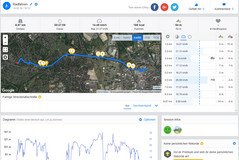
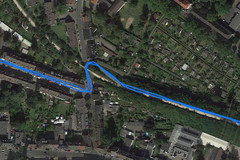
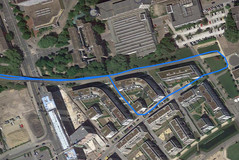

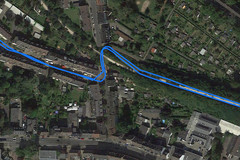
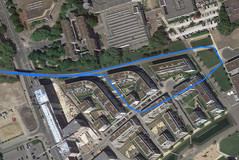



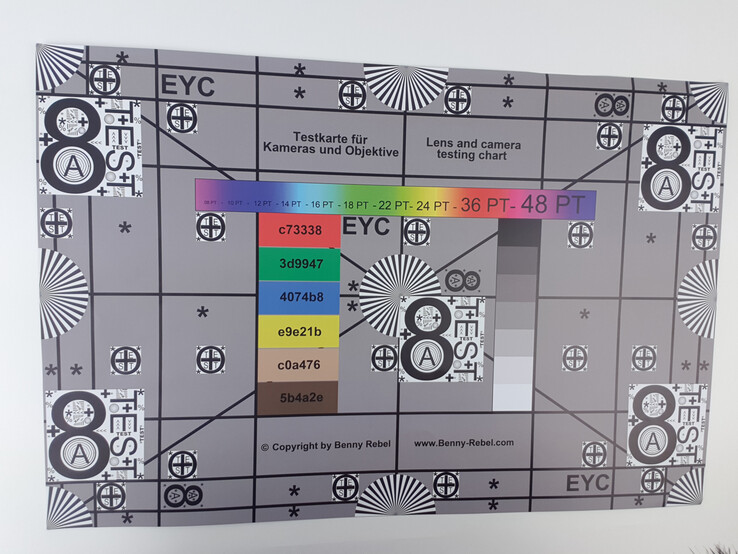







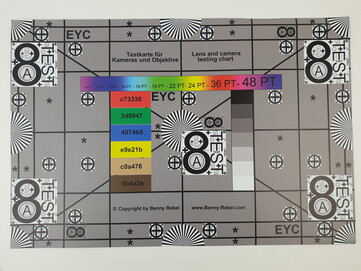
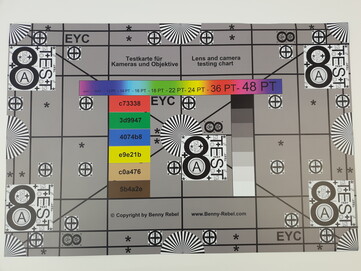


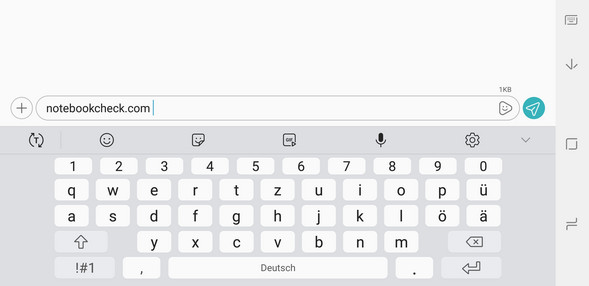
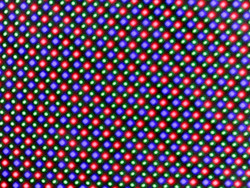
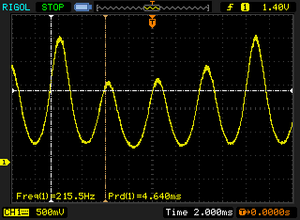

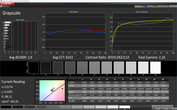
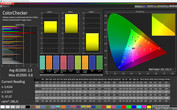
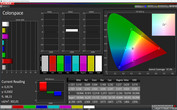
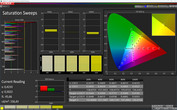
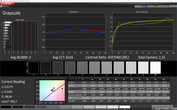
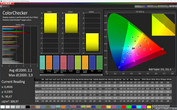
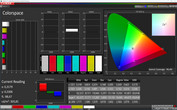
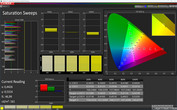
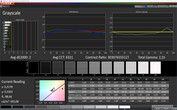
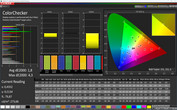
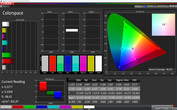
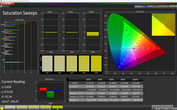
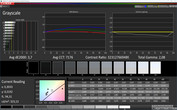
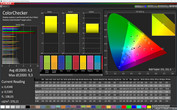
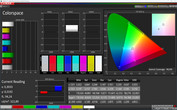
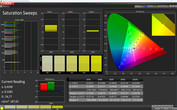
![Grayscales (profile: adaptive [optimized], color space: DCI-P3)](fileadmin/_processed_/b/b/csm_CalMAN_Anpassbar_Optimiert_Grayscale_P3_6cf773c9e3.jpg)
![Mixed colors (profile: adaptive [optimized], color space: DCI-P3)](fileadmin/_processed_/f/9/csm_CalMAN_Anpassbar_Optimiert_ColorChecker_P3_9c20ca22bc.jpg)
